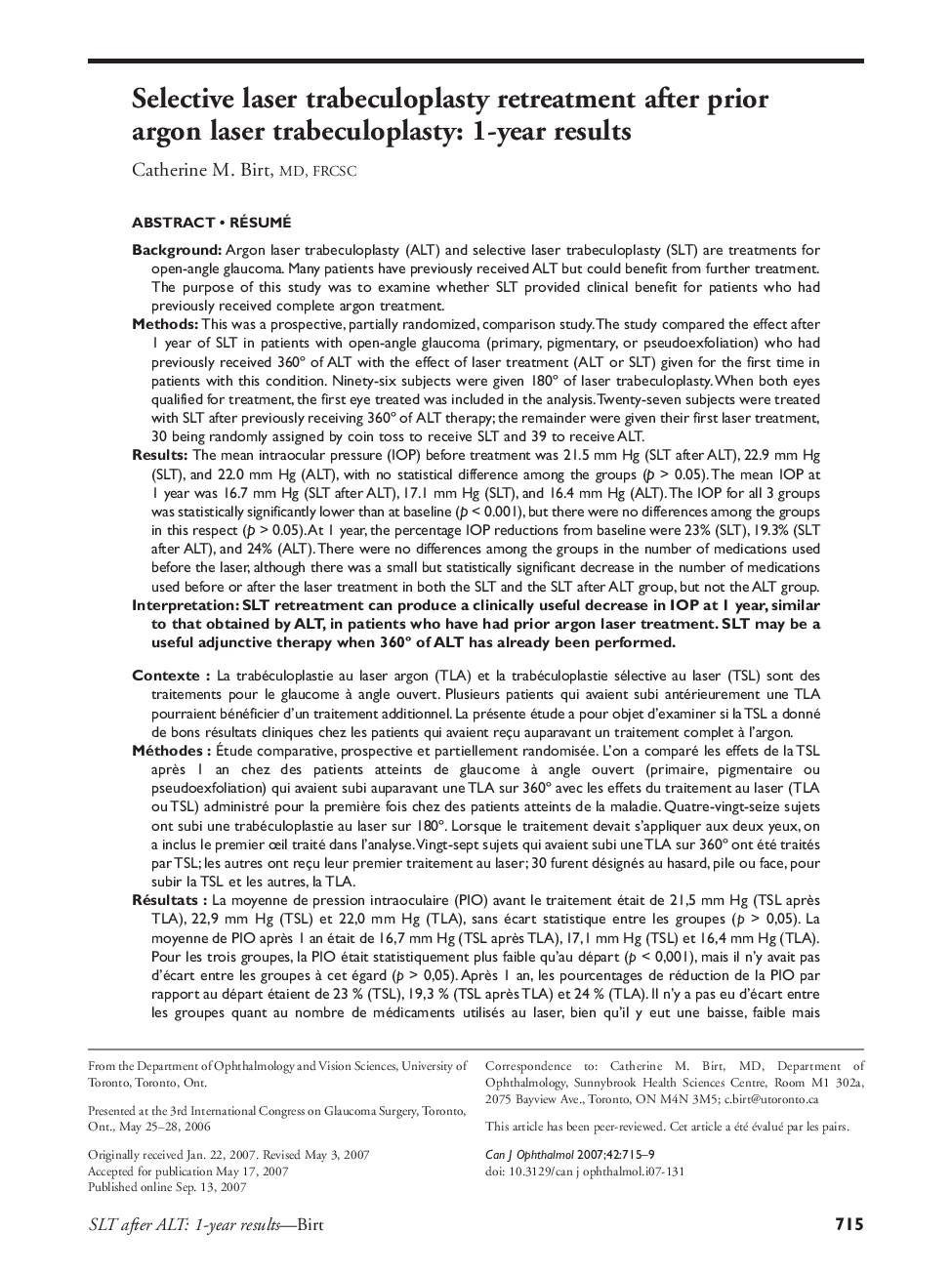| کد مقاله | کد نشریه | سال انتشار | مقاله انگلیسی | نسخه تمام متن |
|---|---|---|---|---|
| 4010871 | 1602448 | 2007 | 5 صفحه PDF | دانلود رایگان |

Background: Argon laser trabeculoplasty (ALT) and selective laser trabeculoplasty (SLT) are treatments for open-angle glaucoma. Many patients have previously received ALT but could benefit from further treatment. The purpose of this study was to examine whether SLT provided clinical benefit for patients who had previously received complete argon treatment.Methods: This was a prospective, partially randomized, comparison study. The study compared the effect after 1 year of SLT in patients with open-angle glaucoma (primary, pigmentary, or pseudoexfoliation) who had previously received 360° of ALT with the effect of laser treatment (ALT or SLT) given for the first time in patients with this condition. Ninety-six subjects were given 180° of laser trabeculoplasty. When both eyes qualified for treatment, the first eye treated was included in the analysis. Twenty-seven subjects were treated with SLT after previously receiving 360° of ALT therapy; the remainder were given their first laser treatment, 30 being randomly assigned by coin toss to receive SLT and 39 to receive ALT.Results: The mean intraocular pressure (IOP) before treatment was 21.5 mm Hg (SLT after ALT), 22.9 mm Hg (SLT), and 22.0 mm Hg (ALT), with no statistical difference among the groups (p > 0.05). The mean IOP at 1 year was 16.7 mm Hg (SLT after ALT), 17.1 mm Hg (SLT), and 16.4 mm Hg (ALT). The IOP for all 3 groups was statistically significantly lower than at baseline (p < 0.001), but there were no differences among the groups in this respect (p > 0.05). At 1 year, the percentage IOP reductions from baseline were 23% (SLT), 19.3% (SLT after ALT), and 24% (ALT). There were no differences among the groups in the number of medications used before the laser, although there was a small but statistically significant decrease in the number of medications used before or after the laser treatment in both the SLT and the SLT after ALT group, but not the ALT group.Interpretation: SLT retreatment can produce a clinically useful decrease in IOP at 1 year, similar to that obtained by ALT, in patients who have had prior argon laser treatment. SLT may be a useful adjunctive therapy when 360° of ALT has already been performed.
RésuméContexte: La trabéculoplastie au laser argon (TLA) et la trabéculoplastie sélective au laser (TSL) sont des traitements pour le glaucome à angle ouvert. Plusieurs patients qui avaient subi antérieurement une TLA pourraient bénéficier d’un traitement additionnel. La présente étude a pour objet d’examiner si la TSL a donné de bons résultats cliniques chez les patients qui avaient reçu auparavant un traitement complet à l’argon.Méthodes: Étude comparative, prospective et partiellement randomisée. L’on a comparé les effets de la TSL après I an chez des patients atteints de glaucome à angle ouvert (primaire, pigmentaire ou pseudoexfoliation) qui avaient subi auparavant une TLA sur 360° avec les effets du traitement au laser (TLA ou TSL) administré pour la première fois chez des patients atteints de la maladie. Quatre-vingt-seize sujets ont subi une trabéculoplastie au laser sur 180°. Lorsque le traitement devait s’appliquer aux deux yeux, on a inclus le premier œil traité dans l’analyse. Vingt-sept sujets qui avaient subi une TLA sur 360° ont été traités par TSL; les autres ont reçu leur premier traitement au laser; 30 furent désignés au hasard, pile ou face, pour subir la TSL et les autres, la TLA.Résultats: La moyenne de pression intraoculaire (PIO) avant le traitement était de 21,5 mm Hg (TSL après TLA), 22,9 mm Hg (TSL) et 22,0 mm Hg (TLA), sans écart statistique entre les groupes (p > 0,05). La moyenne de PIO après 1 an était de 16,7 mm Hg (TSL après TLA), 17,1 mm Hg (TSL) et 16,4 mm Hg (TLA). Pour les trois groupes, la PIO était statistiquement plus faible qu’au départ (p < 0,001), mais il n’y avait pas d’écart entre les groupes à cet égard (p > 0,05). Après I an, les pourcentages de réduction de la PIO par rapport au départ étaient de 23% (TSL), 19,3% (TSL après TLA) et 24% (TLA). Il n’y a pas eu d’écart entre les groupes quant au nombre de médicaments utilisés au laser, bien qu’il y eut une baisse, faible mais statistiquement significative, du nombre de médicaments utilisés après le traitement au laser chez les deux groupes,TSL et TSL après TLA, mais pas chez le groupe TLA.Interprétation: Le traitement par TSL peut entraîner sur le plan clinique une baisse utile de la PIO après I an, semblable à celle obtenue par la TLA, chez les patients qui ont reçu précédemment un traitement au laser argon. La TSL peut offrir une thérapie complémentaire utile lorsque la TLA sur 360° a déjà été pratiquée.
Journal: Canadian Journal of Ophthalmology / Journal Canadien d'Ophtalmologie - Volume 42, Issue 5, October 2007, Pages 715-719